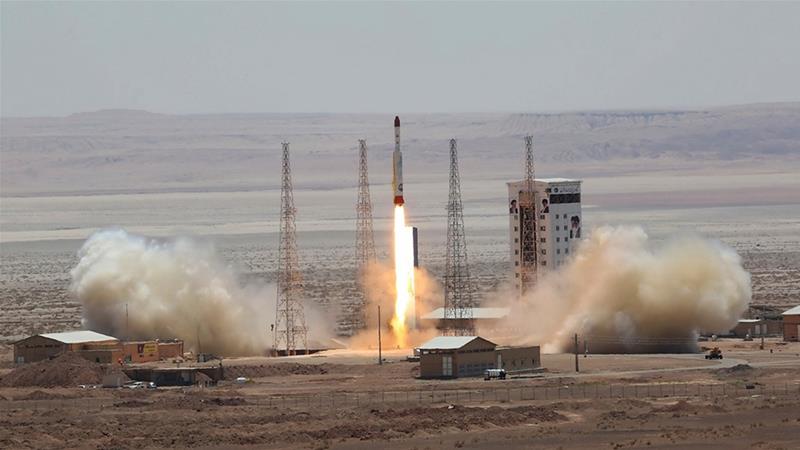“The first satellite of the Islamic Republic of Iran has been successfully launched into orbit by the Islamic Revolutionary Guard Corps [IRGC],” said the elite forces’ official website on Wednesday.
It said the satellite – dubbed the Nour – was deployed from the Qassed two-stage launcher from the Markazi desert, a vast expanse in Iran’s central plateau.
The satellite “orbited the Earth at 425km [264 miles]”, said the website. “This action will be a great success and a new development in the field of space for Islamic Iran.”
The IRGC called it the first military satellite ever launched by Tehran. It used a Ghased, or “Messenger”, satellite carrier to put the device into space, a previously unheard-of system.
As the world grapples with the coronavirus pandemic and historically low oil prices, the missile launch may signal a new willingness to take risks by Iran.
“This raises a lot of red flags,” said Fabian Hinz, a researcher at the James Martin Center for Nonproliferation Studies at the Middlebury Institute of International Studies in Monterey, California.
“Now that you have the [US] maximum pressure campaign, Iran doesn’t have that much to lose any more.”
Hinz said, based on state media images, the launch appeared to have happened at a previously unnamed IRGC base near Shahroud, Iran, some 330km (205 miles) northeast of Tehran. The base is in Semnan province, which hosts the Imam Khomeini Spaceport, from which Iran’s civilian space programme operates.
Navigating armed forces
Al Jazeera’s Zein Basravi, reporting from the capital Tehran, said it was the first time the IRGC took credit for the launch of a military satellite.
“As a military satellite, what we’re likely to see is this to be used specifically for intelligence gathering and secure communications for the navigation of forces on land and sea,” he said.
Tehran has had several failed satellite launches in recent months. The last one came in February when Iran failed to put its Zafar 1 communications satellite into orbit.
That failure came after two failed launches of the Payam and Doosti satellites last year, as well as a launchpad rocket explosion in August. A fire at the Imam Khomeini Space Center in February 2019 also killed three researchers, the authorities said at the time.
The rocket explosion in August drew the attention of US President Donald Trump, who later tweeted what appeared to be a classified surveillance image of the launch failure.
The successive failures raised suspicion of outside interference in Iran’s programme, something Trump himself hinted at by saying the US “was not involved in the catastrophic accident”.
Violent acrimony
Arch-foes Iran and the US have appeared to be on the brink of an all-out confrontation twice in the past year.
Long-standing acrimony between Tehran and Washington was exacerbated in 2018 when Trump unilaterally withdrew from a deal that froze Iran’s nuclear programme, and issued new demands that Tehran curtail its development of ballistic missiles.
Washington has also raised concerns in the past about Tehran’s satellite programme, saying the launch of a carrier rocket in January 2019 amounted to a violation of limits on its ballistic missiles.
Iran maintains it has no intention of acquiring nuclear weapons, and says its aerospace activities are peaceful and comply with a United Nations Security Council resolution.
Over the past 10 years, Iran has sent several short-lived satellites into orbit, and in 2013 it launched a monkey into space.
Wednesday’s launch comes amid tensions between Tehran and Washington over its collapsing nuclear deal and after a US drone attack in Iraq killed IRGC General Qassem Soleimani in January.
Wednesday also marks the 41st anniversary of the founding of the IRGC by Iran’s late leader, Ayatollah Ruhollah Khomeini. An image of the rocket that carried the satellite showed it bore a Quranic verse on overcoming adversaries.
The IRGC, which operates its own military infrastructure in parallel to Iran’s regular armed forces, is a hardline force answerable only to Supreme Leader Ayatollah Ali Khamenei.
It was not immediately clear if Iran’s civilian government knew the launch was coming. President Hassan Rouhani gave nearly a 40-minute speech on Wednesday before his cabinet that included no mention of the launch.
SOURCE: AL JAZEERA AND NEWS AGENCIES

